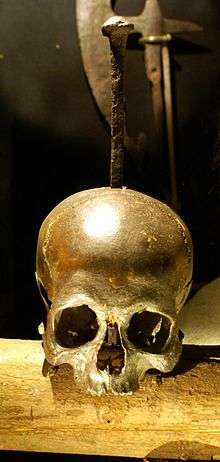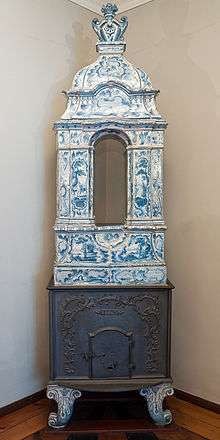Hamburg Museum
| Hamburg Museum | |
|
Entrance of the museum. | |
 Location of Hamburg Museum in Hamburg  Location of Hamburg Museum in Hamburg | |
| Established | 1908 |
|---|---|
| Location | Hamburg, Germany |
| Coordinates | 53°33′04″N 9°58′23″E / 53.551111°N 9.973056°E |
| Type | History museum |
| Website |
www |
The Hamburg Museum, also known as Museum für Hamburgische Geschichte ("Museum for Hamburg History"), is a history museum located in the city of Hamburg in northern Germany. The museum was established at its current location in 1922, although its parent organization was started in 1839. The museum was named hamburgmuseum in 2006. It is located near the Planten un Blomen park in the center of Hamburg.[1] The museum is commonly reviewed among the museums of the city of Hamburg.[2]
History

The Society of Hamburg History (Verein für Hamburgische Geschichte), founded in 1839, started compiling the Collection of Hamburg Antiquities (Sammlung Hamburger Altertümer). First exhibits included architectural fragments of the demolished St. Mary's Cathedral and two monasteries.
The main building at Holstenwall was designed by Fritz Schumacher and constructed between 1914 and 1922.[3]
The museum was built on the site of the former Bastion Henricus, a part of the baroque fortification which was erected between 1616 and 1625 by the Dutchman Jan van Valckenborgh in order to make the town impregnable.
The museum courtyard was damaged in the great fire in 1842 and fully restored in 1995. A glass dome over the inner courtyard was completed in 1989.[4] The glass courtyard was completed by the firm of Von Gerkan, Marg and Partners.[4] This allowed increased museum space without an actual new building, because it allowed increased use of the courtyard.[4] The covered courtyard was actually envisioned, or at least considered, as part of the original design, however the construction of the covering was deferred.[4] The design uses a steel gridshell.[4]
The Hamburg Observatory occupied the area at the Museum from 1825 to 1912 before being moved to Bergedorf. The area was part of the old city wall defences built by the Dutchman Jan van Valckenborgh. These walls were part of Bastion Henricus which was a baroque fortification built between 1616 and 1625.[3] The museum was formerly located at the Johanneum school.
The museum became state-owned under the direction of Otto Lauffer, though this was changed back in 1999.
The museum adopted the name hamburgmuseum, and initials hm, in 2006. In 2008 the museum runs a program called hm freunde (Society of friends of the museum of Hamburg history).[5]

In 2010 a pirate skull with a nail in it was stolen from HM.[6] The skull was discovered in 1878, and forensic analysis believe it to be from the 1400s.[6] At that time it was common for pirates to be executed by being beheaded, and then the skull would be put on an iron stake to display the consequences of this activity.[6] A more precise determination was attempted by the museum in 2004 by DNA analysis, but there was no further confirmation.[6] It was thought this might be from a particular execution of 30 during the age of the Hanseatic League.[6] The skull was stolen on January 9, 2010, and it was thought it may be the skull of (in)famous pirate Klaus Stoertebeker.[7] The skull was added to the museum's collection in 1922.[7]
We are deeply shocked about the theft— HM Museum Director, 2010[7]
In 2016 HM was considered as a candidate for repatriation of a century old German dog-tag.[8] The dog tag belonged to a soldier that had gone MIA in world war one.[9]
Exhibits in 2005
Over time there is a gradual shift with some temporary exhibits also. Here the exhibits around 2005

- Kleidung und Mode: Kostüme und Kleidung in Hamburg von 1550–1920 (Clothing and fashion: costumes and clothing in Hamburg from 1550-1920)
- Hamburgisches Mäzenatentum: Familie Lorenz-Meyer als Beispiel (Hamburgian Patronage: The example of the Lorenz-Meyer family)
- Musik und Kunst in Hamburg (Music and art in Hamburg)
- Theater und Wissenschaft in Hamburg (Theatre and science in Hamburg)
- Hamburg im 20. Jahrhundert (Hamburg in the 20th century)
- Der Hamburger Börsenvorplatz von 1558 (The forecourt of the Hamburgian exchange of 1558)
- Hamme, Burg und Hansestadt – Hamburg im Mittelalter ( Hamme, castle and city of the Hanse - Hamburg in mediaeval times)
- Kirchen, Kanonen und Kommerz – Hamburg in der frühen Neuzeit (Churches, canons and commerce - Hamburg in the early modern period)
- Reformation in Hamburg (Reformation in Hamburg)
- Hamburg als Währungszentrum (Hamburg as centre of currencies)
- Das Schiffswrack von Wittenbergen (The shipwreck of Wittenbergen)
- Bauen und Wohnen und die Sicherung der Elbe vor Piraten (Constructing and living and securing the Elbe from pirates)
- Barocke Kaufmannsdiele (Baroque merchant hall)
- Stadtbild und Verfassung im 17. Jahrhundert (Townscape and constitution in the 17th century)
- Hamburg 1650-1860 (Hamburg 1650-1860)
- Die HafenCity – Hamburg im 21. Jahrhundert (The HafenCity - Hamburg in the 21st century)
- Kommandobrücke des Dampfers WERNER (The command bridge of steamboat WERNER)
- Zur Wohnkultur (About home decor)
- Geschichte der Juden in Hamburg [10] (History of the Jews in Hamburg)
- Klopstockzimmer (The Klopstock room)
- Barocke Wohnräume (Baroque living rooms)
- Kunsthandwerk und Wohnkultur (Handicraft and home decor)
- 1945. Kriegsende in Hamburg (1945. End of the war in Hamburg)
Interior and contents

The museum has many artifacts preserved by the Society of Hamburg History founded in 1839. The Petri portal from Hamburg's St. Petri Church, built in 1604, was built into the museum courtyard in the 1990s.[11]
The museum is known for having miniature scale models that show the history of the port.[12] It is also a site for the club MEHEV, and the museum as one of the largest scale model railroads.[13]
Permanent Exhibitions

The museum's website lists its permanent exhibitions as:
- Hamburg in the 20th Century
- Hamburg’s Historical Highlights
- Medieval Hamburg
- Hamburg and the Church
- Hamburg in the Early Modern Age
- Baroque Merchant Hall
- Cityscape and Constitution in the 17th Century
- The Dawning of the Modern Age
- The 1842 Fire
- Emigration via Hamburg
- Maritime Trade
- Hamburg in the 21st Century
- Navigation Bridge of the Werner Steamship
- The Arrival of the First Jews in Hamburg
- Enlightenment and Emancipation
- During the German Empire
- The Weimar Republic
- Persecution and the holocaust under the National Socialist regime
- Jewish Schools
- Jews and business in Hamburg
- Jewish Residential Areas and Living Conditions
- The Synagogue
Visitors
The museum takes part in the Long Night of Museums of Hamburg.[14]
See also
References
- ↑
- ↑ "Museum of Hamburg History (Hamburgmuseum) (Germany): Top Tips Before You Go - TripAdvisor". www.tripadvisor.com. Retrieved 2017-01-13.
- 1 2 The Museum, Hamburg Museum, accessed December 2011
- 1 2 3 4 5
- ↑ Society of Friends of the Museum of Hamburg History, hamburgmuseum, accessed December 2011
- 1 2 3 4 5
- 1 2 3
- ↑
- ↑ "Tracing private Fatsch: A 100-year journey to repratriate German dog tag". Stuff. Retrieved 2017-01-13.
- ↑ Pelc, Ortwin. "Jews In Hamburg". (trans. Guido G. Möring). University of Hamburg. Retrieved 2009-08-29.
- ↑ Hamburg Museum website, in English, accessed November 2012
- ↑
- ↑ TravelDudes (2010-04-14). "11 Popular Museums in Hamburg, Germany". Traveldudes.org. Retrieved 2017-01-13.
- ↑ "Lange Nacht der Museen Museum für Hamburgische Geschichte" (in German). Der Museumsdienst Hamburg. Retrieved 2009-08-29. External link in
|publisher=(help)
Further reading
- Horbas, Claudia; Pelc, Ortwin (2002). Es brannte an allen Ecken und Enden zugleich – Hamburg 1842 Zur Ausstellung im Museum für Hamburgische Geschichte, Nov. 2002 bis Febr. 2003 (in German). Heide: Boyens. ISBN 978-3-8042-1114-8.
External links
| Wikimedia Commons has media related to Hamburg Museum. |
- Hamburgmuseum Portal(in English)
- Verein der Freunde des Museums für Hamburgische Geschichte e.V.
- Stiftung Historische Museen Hamburg
- Modelleisenbahn Hamburg e.V. (Hamburg Model Railway Society, website only in German)
